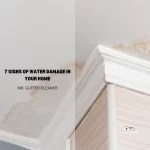Water damage poses a significant threat to homes, affecting the integrity and safety of structures while potentially leading to costly repairs.
This introduction outlines the importance of understanding water damage sources, early detection methods, immediate steps post-detection, cleanup processes, prevention strategies, insurance considerations, health risks, and frequently asked questions.
Burst pipes, roof leaks, and natural disasters are primary culprits of water damage, emphasizing the need for homeowners to recognize early signs such as discoloration, unusual odors, or mold growth. Quick detection through moisture meters can mitigate damages significantly.
Upon discovering water damage, turning off the main water supply and contacting professional restoration services promptly are crucial actions. The cleanup process involves water removal, drying, dehumidifying, and sanitizing affected areas.
Emphasizing prevention, regular maintenance, and waterproofing can drastically reduce future risks. Understanding homeowners insurance coverage for water damage, including policy terms and claim filing, is essential. Additionally, acknowledging the health risks associated with water damage, such as mold and mildew, highlights the importance of swift action.
What Causes Water Damage in Homes?
Understanding the common causes of water damage is crucial for maintaining a safe and healthy home environment. Water damage can occur from various sources, each necessitating specific preventive measures.
How Do Pipes Burst and Leak?
Pipes can burst and leak due to several reasons, including freezing temperatures, corrosion, high water pressure, and physical damage. When water inside pipes freezes, it expands, causing pipes to crack and leak once the ice melts.
Table of Contents:
What Leads to Roof Leaks?
Roof leaks are often caused by missing or damaged shingles, cracked flashing, or blocked gutters. Regular roof inspections can identify potential issues before they lead to significant water damage.
Are Natural Disasters the Only Cause of Flooding?
While natural disasters like hurricanes and heavy rains are major flooding causes, they are not the only ones. Overflows from sewage systems, pipe bursts, and malfunctioning sump pumps can also cause significant flooding in homes.
How to Identify Water Damage Early?
Early identification of water damage is crucial for preventing structural damage and health issues in homes. Homeowners should be vigilant for any signs that may indicate the presence of water damage. Regular inspections can help catch issues before they escalate, saving both money and time in repairs.
What Are the Signs of Hidden Water Damage?
Hidden water damage can manifest in various ways, often subtle and unnoticed until significant damage has occurred. Key signs include unusual musty odors, peeling paint or wallpaper, staining on walls and ceilings, warping or buckling of flooring, and the presence of mold or mildew in unusual places. These indicators suggest moisture accumulation that’s not immediately visible, necessitating a closer inspection.
Using Moisture Meters to Detect Water Damage
Moisture meters are invaluable tools in the early detection of water damage. These devices measure the moisture content in materials, helping to pinpoint areas of dampness that are not visible to the naked eye. By using moisture meters during routine inspections, homeowners can identify potentially problematic areas early on, allowing for prompt remediation before the moisture causes more extensive damage.
Immediate Steps After Detecting Water Damage
Upon discovering water damage, taking immediate action is critical to mitigate further damage and start the recovery process efficiently.
Should You Turn Off the Main Water Supply?
Yes, turning off the main water supply is essential if the water damage stems from a plumbing issue.
This step prevents additional water from contributing to the damage, allowing you to assess the situation safely and begin the drying process.
When to Contact Water Damage Restoration Services?
Contacting water damage restoration services should be done as soon as possible after detecting water damage, especially if the damage is extensive or if there are risks of structural damage and mold growth.
Professional services have the expertise, equipment, and experience to effectively dry out, clean, and restore the affected areas, ensuring your home returns to a safe and livable condition promptly.
The Process of Water Damage Cleanup
Initiating water damage cleanup involves a detailed plan that prioritizes safety and effectiveness. The process is designed to restore environments affected by water damage through several critical stages, each requiring careful attention to detail and adherence to safety standards.
How to Begin the Cleanup Process?
The cleanup process starts with a thorough assessment of the damage to identify the source and extent of water intrusion. Safety measures, such as turning off electricity and wearing protective gear, are essential. Documentation for insurance claims is also a crucial early step.
Safe Removal of Water
Removing standing water is the immediate priority. This is typically done using submersible pumps or wet vacuums, depending on the volume of water. It’s vital to act quickly to minimize structural damage and mitigate the risk of mold growth.
Drying and Dehumidifying the Area
After water removal, drying out the affected areas is critical. Industrial-strength air movers and dehumidifiers are used to accelerate the drying process. This step may take several days, depending on the severity of the water damage.
Cleaning and Sanitizing After Water Damage
Post-drying, cleaning, and sanitizing are necessary to remove any contaminants. This includes disinfecting surfaces and potentially discarding non-salvageable items to prevent health hazards.
What Is the Role of Professional Water Damage Services?
Professional water damage services play a crucial role in efficiently managing the cleanup process. They offer expertise in water extraction, drying, cleaning, and restoration services, equipped with the necessary tools and knowledge to handle complex situations. Their involvement ensures that the cleanup is thorough, reducing the long-term impacts of water damage on the property.
Preventing Future Water Damage
Preventing water damage involves proactive measures and regular maintenance to safeguard your home against potential threats. It’s essential to address vulnerabilities and implement strategies to minimize risks.
Regular Maintenance Tips for Homeowners
Homeowners can prevent water damage through routine inspections and maintenance. This includes cleaning gutters and downspouts, inspecting roofs and windows for leaks, maintaining plumbing systems, and monitoring water bills for unexpected increases that could indicate leaks.
Waterproofing Your Home: Is It Worth It?
Waterproofing your home is an effective way to protect against water damage. This can include applying sealants to basements, installing backwater valves, and ensuring proper drainage around the foundation. The investment in waterproofing can significantly reduce the risk of damage and save on costly repairs in the long run.
Does Homeowners Insurance Cover Water Damage?
Understanding your homeowners insurance policy is crucial in determining coverage for water damage. Policies often cover specific scenarios, so it’s important to know what is and isn’t included.
What Do Homeowners’ Policies Typically Cover?
Most homeowners insurance policies cover water damage caused by sudden and accidental incidents, such as plumbing failures or storms. However, damage due to lack of maintenance or floods typically requires additional coverage.
How to File a Claim for Water Damage?
Filing a claim involves documenting the damage thoroughly, contacting your insurance provider promptly, and following their guidance. Keeping detailed records and photographs can support your claim, ensuring a smoother process.
Health Risks Associated with Water Damage
Water damage can lead to significant health risks if not properly addressed. The presence of moisture creates an ideal environment for mold and mildew to thrive, which can cause respiratory issues and other health problems.
Identifying Mold and Mildew Risks
Mold and mildew growth can often be identified by a musty odor and visible growth on surfaces. These fungi can grow on almost any surface exposed to moisture and can start to develop within 24 to 48 hours after exposure to water.
Preventing Health Hazards After Flooding
To prevent health hazards after flooding, it’s crucial to remove standing water, dry out the affected areas thoroughly, use air purifiers, and ensure good ventilation. Contaminated materials should be cleaned or removed to prevent the spread of mold and other pathogens.
FAQs on Water Damage Cleanup
Addressing common questions can help homeowners better understand the implications of water damage and the necessary steps for cleanup and prevention.
Can Water Damage Weaken Home Structures?
Yes, water damage can weaken home structures over time. Prolonged exposure to moisture can deteriorate building materials, leading to structural issues.
How Long Does It Take for Mold to Grow After a Leak?
Mold can start to grow within 24 to 48 hours after a leak or exposure to moisture. Quick action is essential to prevent its development and spread.


